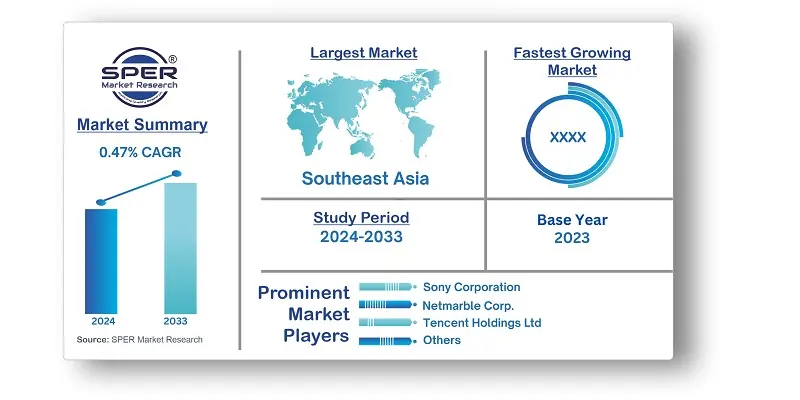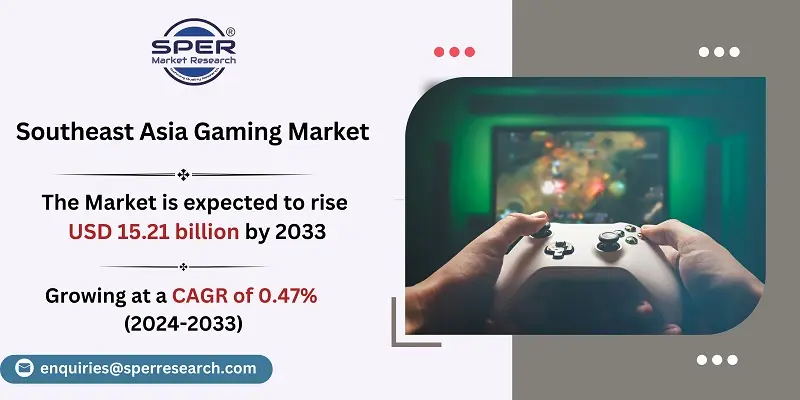
Southeast Asia Gaming Market Growth, Trends, Size, Revenue, Challenges and Future Outlook
Southeast Asia Gaming Market Size- By Platform - Regional Outlook, Competitive Strategies and Segment Forecast to 2033
| Published: Jul-2024 | Report ID: IACT24131 | Pages: 1 - 157 | Formats*: |
| Category : Information & Communications Technology | |||
- Microsoft has stated that PC Game Pass will be available in Thailand, Malaysia, Indonesia, the Philippines, and Vietnam starting in March 2022. Gamers may register for the PC Game Pass preview, which gives them access to over 100 top-notch titles, including Bethesda titles, Xbox Game Studios titles that are released on day one, and an EA Play membership that costs just $5 per month.
- September 2022: Ragnarok Tactics II, a wholly-owned subsidiary, was successfully released in Thailand, according to GRAVITY Co. Ltd., a publisher and developer of online and mobile games. In the tactical role-playing game Ragnarok Tactics II, players advance their characters' levels by collecting monsters. Players engage in combat with both their characters and the game's beasts.


| Report Metric | Details |
| Market size available for years | 2020-2033 |
| Base year considered | 2023 |
| Forecast period | 2024-2033 |
| Segments covered | By Platform |
| Regions covered | Germany, Indonesia, Malaysia, Singapore, Thailand, Rest of Southeast Asia |
| Companies Covered | Asiasoft Corporation Public Company Limited, Bandai Namco Entertainment Asia Pte. Ltd., Com2uS Group, IGG, Netmarble Corp., Nintendo, Sea Limited, Sherman Chin, Sony Corporation, Tencent Holdings Ltd. |
- Core Gamers
- Casual Gamers
- Esports Enthusiasts
- Parents and Families
- Mobile Gamers
- PC Gamers
- Console Gamers
| By Platform: |
|
- Southeast Asia Gaming Market Size (FY’2024-FY’2033)
- Overview of Southeast Asia Gaming Market
- Segmentation of Southeast Asia Gaming Market By Platform (PC, Console, Mobile)
- Expansion Analysis of Southeast Asia Gaming Market
- Problems and Obstacles in Southeast Asia Gaming Market
- Competitive Landscape in the Southeast Asia Gaming Market
- Impact of COVID-19 and Demonetization on Southeast Asia Gaming Market
- Details on Current Investment in Southeast Asia Gaming Market
- Competitive Analysis of Southeast Asia Gaming Market
- Prominent Players in the Southeast Asia Gaming Market
- SWOT Analysis of Southeast Asia Gaming Market
- Southeast Asia Gaming Market Future Outlook and Projections (FY’2024-FY’2033)
- Recommendations from Analyst
1.1. Scope of the report1.2. Market segment analysis
2.1. Research data source
2.1.1. Secondary Data2.1.2. Primary Data2.1.3. SPER’s internal database2.1.4. Premium insight from KOL’s
2.2. Market size estimation
2.2.1. Top-down and Bottom-up approach
2.3. Data triangulation
4.1. Driver, Restraint, Opportunity and Challenges analysis
4.1.1. Drivers4.1.2. Restraints4.1.3. Opportunities4.1.4. Challenges
4.2. COVID-19 Impacts of the Southeast Asia Gaming Market
5.1. SWOT Analysis
5.1.1. Strengths5.1.2. Weaknesses5.1.3. Opportunities5.1.4. Threats
5.2. PESTEL Analysis
5.2.1. Political Landscape5.2.2. Economic Landscape5.2.3. Social Landscape5.2.4. Technological Landscape5.2.5. Environmental Landscape5.2.6. Legal Landscape
5.3. PORTER’s Five Forces
5.3.1. Bargaining power of suppliers5.3.2. Bargaining power of buyers5.3.3. Threat of Substitute5.3.4. Threat of new entrant5.3.5. Competitive rivalry
5.4. Heat Map Analysis
6.1. Southeast Asia Gaming Market Manufacturing Base Distribution, Sales Area, Product Type6.2. Mergers & Acquisitions, Partnerships, Product Launch, and Collaboration in Southeast Asia Gaming Market
7.1. Southeast Asia Gaming Market Size, Share and Forecast, By Platform, 2020-20267.2. Southeast Asia Gaming Market Size, Share and Forecast, By Platform, 2027-20337.3. PC7.4. Console7.5. Mobile
8.1. Southeast Asia Gaming Market Size and Market Share
9.1. Southeast Asia Gaming Market Size and Market Share By Region (2020-2026)9.2. Southeast Asia Gaming Market Size and Market Share By Region (2027-2033)9.3. Germany9.4. Indonesia9.5. Malaysia9.6. Singapore9.7. Thailand9.8. Rest of Southeast Asia
10.1. Asiasoft Corporation Public Company Limited
10.1.1. Company details10.1.2. Financial outlook10.1.3. Product summary10.1.4. Recent developments
10.2. Bandai Namco Entertainment Asia Pte. Ltd.
10.2.1. Company details10.2.2. Financial outlook10.2.3. Product summary10.2.4. Recent developments
10.3. Com2uS Group
10.3.1. Company details10.3.2. Financial outlook10.3.3. Product summary10.3.4. Recent developments
10.4. IGG
10.4.1. Company details10.4.2. Financial outlook10.4.3. Product summary10.4.4. Recent developments
10.5. Netmarble Corp.
10.5.1. Company details10.5.2. Financial outlook10.5.3. Product summary10.5.4. Recent developments
10.6. Nintendo
10.6.1. Company details10.6.2. Financial outlook10.6.3. Product summary10.6.4. Recent developments
10.7. Sea Limited
10.7.1. Company details10.7.2. Financial outlook10.7.3. Product summary10.7.4. Recent developments
10.8. Sherman Chin
10.8.1. Company details10.8.2. Financial outlook10.8.3. Product summary10.8.4. Recent developments
10.9. Sony Corporation
10.9.1. Company details10.9.2. Financial outlook10.9.3. Product summary10.9.4. Recent developments
10.10. Tencent Holdings Ltd
10.10.1. Company details10.10.2. Financial outlook10.10.3. Product summary10.10.4. Recent developments
10.11. Others
SPER Market Research’s methodology uses great emphasis on primary research to ensure that the market intelligence insights are up to date, reliable and accurate. Primary interviews are done with players involved in each phase of a supply chain to analyze the market forecasting. The secondary research method is used to help you fully understand how the future markets and the spending patterns look likes.
The report is based on in-depth qualitative and quantitative analysis of the Product Market. The quantitative analysis involves the application of various projection and sampling techniques. The qualitative analysis involves primary interviews, surveys, and vendor briefings. The data gathered as a result of these processes are validated through experts opinion. Our research methodology entails an ideal mixture of primary and secondary initiatives.



Frequently Asked Questions About This Report
PLACE AN ORDER
Year End Discount
Sample Report
Pre-Purchase Inquiry
NEED CUSTOMIZATION?
Request CustomizationCALL OR EMAIL US
100% Secure Payment






Related Reports
Our Global Clients
Our data-driven insights have influenced the strategy of 200+ reputed companies across the globe.




















